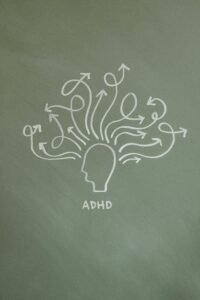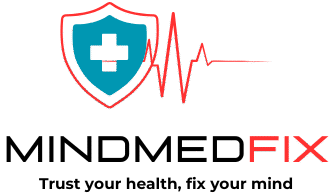10 Most Common Mental Health Disorders in the USA. Mental health contributes a lot to overall health. However, millions of individuals across the United States of America deal with severe mental health problems annually. According to the latest mental health statistics for the USA as of 2024, nearly one in five adults experienced some form of mental illness during the year 2023. An adequate understanding of the common mental health disorders of the USA — as well as the realization of the symptoms of mental health disorders — are all essential to enable timely intervention, support, and restoration. The following article provides an overview of America’s most common mental diseases, describing the signs of each in order to more inform and introduce empathy.
-
Anxiety Disorders

Anxiety disorders are among the most prevalent mental conditions in the USA and it is one of the mental health disorder. Recent research in 2023 puts around 19% of American adults as affected by anxiety over a period of one year. Early detection of symptoms and signs of anxiety disorders significantly improves outcomes.
Common symptoms are:
- Recurring thoughts of worry or fear
- Restlessness or feeling continually “on edge”
- Finding it difficult to concentrate
- Disturbances during sleep
- Physical signs, such as sweating or racing heartbeat
-
Major Depressive Disorder (Depression)

Depression continues to be a leading cause of disability across the United States. Trends between 2023 and the first part of 2024 show a clear increase in the number of adults participating. Even though the burden on daily activities is variable from person to person, it always impacts emotional, intellectual, and physical function.
Some of the common symptoms are:
- Depression or feelings of hopelessness that last weeks or months
- Loss of pleasure or interest in activities previously enjoyed
- Markedly changed appetite or weight
- Inability to sleep, or too much sleep
- Guilt, worthlessness, or helplessness, thoughts of
- Suicide or death, thoughts of
-
Bipolar Disorder

Bipolar disorder symptoms described include sudden changes between cycles of heightened mood (mania) and cycles of depression. As identified in 2024 updated diagnoses, bipolar disorder is still a serious mental illness that touches Americans of every age.
Symptoms of manic episodes are:
- Overabundance of energy and activity;
- Elevated self-esteem or grandiosity;
- Reduced need for sleep;
- Impulsivity or reckless behavior.
Symptoms of depressive episodes resemble those observed in major depressive disorder.
-
Post-Traumatic Stress Disorder (PTSD)

Post-traumatic stress disorder is most commonly induced following exposure or observing of a traumatic incident. 2023 news had spoken of the severity of PTSD symptoms after trauma, particularly in experts, emergency responders, and assault victims.
Common signs are:
- Disturbing memories, flashbacks, or nightmares about the traumatic event;
- Avoidance of reminders linked with the trauma;
- Negative alterations in mood and thought;
- Hyperarousal, for example, being startle-prone or always feeling “on edge.”
-
Obsessive-Compulsive Disorder (OCD)

Obsessive-compulsive disorder (OCD) is a complex condition that can seriously damage daily functioning. A study released in 2023 identifies how OCD impacts mental health, usually confining individuals in patterns of intrusive thoughts (obsessions) and repetitive actions (compulsions).
Common symptoms are:
- Symptoms of contamination, harm, or symmetry-related fears;
- Intrusive and unwanted thoughts;
- Compulsive acts like excessive cleaning, checking, or counting;
- Temporary relief only after doing compulsions.
-
Schizophrenia
Schizophrenia is a severe psychiatric disorder that involves conflicts in thinking, perception, mood, and behavior. Strides in 2024 have continued to stress the consequence of early warning signs of schizophrenia in order to facilitate early intervention.
Some of the common signs include:
- Illusions (seeing or hearing things that are not there);
- Misconceptions (illogical thoughts that are not reality-based);
- Confused speech or activity;
- Social withdrawal;
- Dull expression of emotion.
-
Attention-Deficit/Hyperactivity Disorder (ADHD)

Although it’s generally associated with children, Attention-Deficit/Hyperactivity Disorder (ADHD) perseveres into adulthood for the majority. Findings of the 2024 report on adult mental health confirm the necessity of taking adult ADHD symptoms into account.
Some common signs are:
- Repeated distractibility and inattentiveness;
- Restlessness or hyperactivity that requires continual movement;
- Impulsivity that often leads to poor choices;
- Struggling to stay organized and tendency to forget.
Borderline Personality Disorder (BPD)
Borderline Personality Disorder (BPD) imposes an important burden on emotional regulation, relationships, and self-esteem. Public awareness campaigns implemented in 2023 facilitated reduced stigma and increased early detection.
Symptoms commonly seen:
- Inordinate fear of abandonment;
- Highly intense or unstable interpersonal relationships;
- Sudden mood changes;
- Impulsive, repeatedly self-damaging activities;
- Emptiness for months;
- Self-harm or suicidal behavior;
-
Eating Disorders

Eating disorders are severe diseases with potentially life-threatening consequences if not treated. 2024 data show a concerning increase in cases, especially among young adults and teenagers. The following Types are:
Anorexia nervosa:
- Extreme food limitation;
- Distorted body image and excessive fear of gaining weight.
Bulimia nervosa:
- Alternating cycles of binge eating and compensatory behavior, e.g., vomiting or excessive exercise.
Binge-Eating Disorder:
- Cycles of recurrent excessive food intake without purging;
- Shame or guilt feelings after overeating.
-
Substance Use Disorders (SUDs)

Substance Use Disorders (SUDs) refer to uncontrolled use of alcohol, drugs, or other substances. Patterns of substance use reported towards the close of 2023 indicate increasing incidence as a result of ongoing stressors in society.
Symptoms shared by them are:
- Strong craving and urge for the substance;
- Lack of ability to control or reduce use despite negative consequences;
- Abandonment of work, home, or school responsibilities;
- Prolonged use even with engagement in risks when drunk;
- Physiological signs when abstaining.
Recognizing Mental Health Disorder Symptoms Early
Early detection of mental health symptoms significantly enhances the chances of successful intervention. The presence of treatment for mental health conditions — therapy, medication, and support programs — increased especially between 2023 and 2024, highlighting the importance of early care.
If you or someone you know has displayed emotional distress, behavioral change, or trouble coping with daily life, it is strongly advised to contact a licensed mental health practitioner for assistance.
Conclusion
Mental illness exists but is also very treatable. Whether one has anxiety, depression, OCD, PTSD, an eating disorder, or addiction, there is expert care and community support available to assist. Considerate of the types of mental illness and symptoms therefrom, based on present knowledge available through 2023 and 2024, instills sympathy, lessens stigma, and makes communities more resilient.
As professionals are so fond of reminding us, “Your mental well-being is not a luxury; it is a necessity.”
If you, or a loved one, are suffering from mental illness, calling out is not weakness — it’s the start of healing and hope.
Read about Mental Health Nursing: A Guide for Nurses




